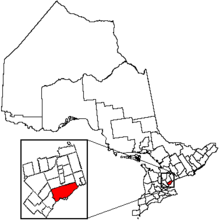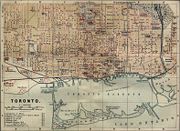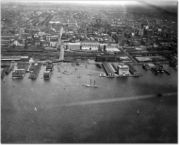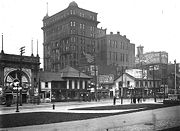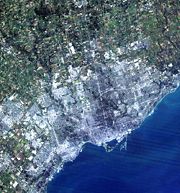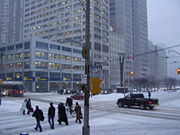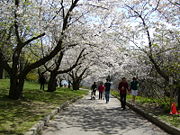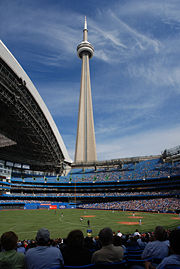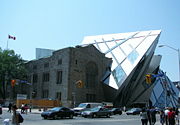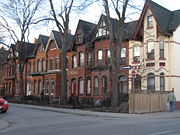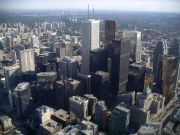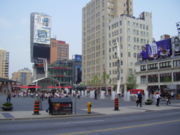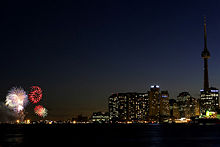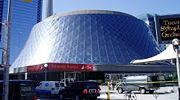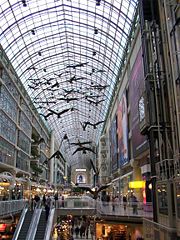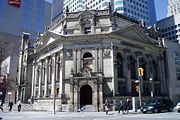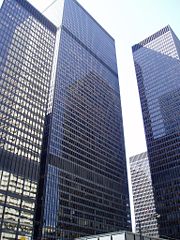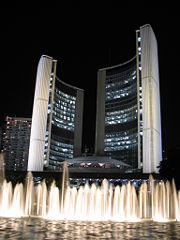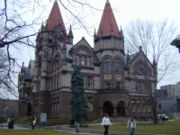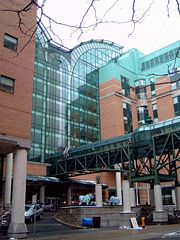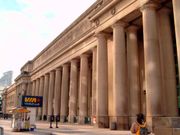Toronto
2008/9 Schools Wikipedia Selection. Related subjects: Cities; North America
| City of Toronto | |||
|
|||
| Nickname(s): T.O., Hogtown, The Big Smoke, Toronto the Good, T-Dot | |||
| Motto: Diversity Our Strength | |||
| Location of Toronto and its census metropolitan area in the province of Ontario | |||
| Coordinates: | |||
|---|---|---|---|
| Country | Canada | ||
| Province | Ontario | ||
| Districts | East York, Etobicoke, North York, Old Toronto, Scarborough, York | ||
| Established | August 27, 1793 | ||
| Incorporated | March 6, 1834 | ||
| Amalgamated | January 1, 1998 | ||
| Government | |||
| - Mayor | David Miller | ||
| - Council | Toronto City Council | ||
| - MPs |
List of MPs
|
||
| - MPPs |
List of MPPs
|
||
| Area | |||
| - City | 630 km² (243.2 sq mi) | ||
| - Urban | 1,749 km² (675.3 sq mi) | ||
| - Metro | 7,125 km² (2,751 sq mi) | ||
| Elevation | 76 m (249 ft) | ||
| Population (2006) | |||
| - City | 2,503,281 | ||
| - Density | 3,972/km² (10,287.4/sq mi) | ||
| - Urban | 4,753,120 | ||
| - Metro | 5,555,912 | ||
| - Demonym | Torontonian | ||
| Time zone | EST ( UTC-5) | ||
| - Summer ( DST) | EDT ( UTC-4) | ||
| Postal code span | M | ||
| Area code(s) | (416) and (647) | ||
| NTS Map | 030M11 | ||
| GNBC Code | FEUZB | ||
| Website: toronto.ca | |||
Toronto (IPA: /təˈrɒntoʊ/, colloquially pronounced [ˈtrɑnoʊ] or [təˈɹɑnoʊ]) is the largest city in Canada and is the provincial capital of Ontario. It is located on the northwestern shore of Lake Ontario. With over 2.5 million residents, it is the fifth-most populous municipality in North America. Toronto is at the heart of the Greater Toronto Area (GTA), and is part of a densely-populated region in south-central Ontario known as the Golden Horseshoe which is home to 8.1 million residents. The census metropolitan area (CMA) had a population of 5,113,149, and the Greater Toronto Area had a population of 5,555,912 in the 2006 Census.
As Canada's economic capital, Toronto is considered a global city and is one of the top financial cities in the world. Toronto's leading economic sectors include finance, business services, telecommunications, aerospace, transportation, media, arts, film, television production, publishing, software production, medical research, education, tourism and sports industries. The Toronto Stock Exchange, the world's seventh largest, is headquartered in the city, along with a majority of Canada's corporations.
Toronto's population is cosmopolitan and international, reflecting its role as an important destination for immigrants to Canada. Toronto is one of the world's most diverse cities by percentage of non-native-born residents, as about 49 percent of the population were born outside of Canada. Because of the city's low crime rates, clean environment, generally high standard of living, and friendlier attitudes to diversity, Toronto is consistently rated as one of the world's most livable cities by the Economist Intelligence Unit and the Mercer Quality of Living Survey. In addition, Toronto was ranked as the most expensive Canadian city in which to live in 2006. Residents of Toronto are called Torontonians.
History
When Europeans first arrived at the site of present-day Toronto, the vicinity was inhabited by the Huron tribes, who by then had displaced the Iroquois tribes that occupied the region for centuries before c. 1500. The name Toronto is likely derived from the Iroquois word tkaronto, meaning "place where trees stand in the water". It refers to the northern end of what is now Lake Simcoe, where the Huron had planted tree saplings to corral fish. A portage route from Lake Ontario to Lake Huron running through this point, the Toronto Carrying-Place Trail, led to widespread use of the name.
French traders founded Fort Rouillé on the current Exhibition grounds in 1750, but abandoned it in 1759. During the American Revolutionary War, the region saw an influx of British settlers as United Empire Loyalists fled for the unsettled lands north of Lake Ontario. In 1787, the British negotiated the Toronto Purchase with the Mississaugas of New Credit, thereby securing more than a quarter million acres (1000 km²) of land in the Toronto area.
In 1793, Governor John Graves Simcoe established the town of York on the existing settlement, naming it after Prince Frederick, Duke of York and Albany. Simcoe chose the town to replace Newark as the capital of Upper Canada, believing the new site would be less vulnerable to attack by the Americans. Fort York was constructed at the entrance of the town's natural harbour, sheltered by a long sand-bar peninsula. The town's settlement formed at the eastern end of the harbour behind the peninsula, near the present-day Parliament Street and Front Street.
In 1813, as part of the War of 1812, the Battle of York ended in the town's capture and plunder by American forces. The surrender of the town was negotiated by John Strachan. American soldiers destroyed much of Fort York and set fire on the parliament buildings during their five-day occupation.
York was incorporated as the City of Toronto on March 6, 1834, reverting to its original native name. The population of only 9,000 included escaped African American slaves fleeing Black Codes in some states. Slavery was banned outright in Upper Canada in 1834. Reformist politician William Lyon Mackenzie became the first Mayor of Toronto, and led the unsuccessful Upper Canada Rebellion of 1837 against the British colonial government. The city grew rapidly through the remainder of the 19th century, as a major destination for immigrants to Canada. The first significant population influx occurred with the Great Irish Famine between 1846 and 1849 that brought a large number of Irish into the city, some of them transient and most of them Catholic. By 1851, the Irish-born population had become the largest single ethnic group in the city. Smaller numbers of Protestant Irish immigrants were welcomed by the existing Scottish and English population, giving the Orange Order significant influence over Toronto society.
Toronto was twice for brief periods the capital of the united Province of Canada first from 1849-1852, following unrest in Montreal, and later 1856-1858 after which Quebec became capital until 1866 (one year prior to Confederation); since then, the capital has been Ottawa. As it had been for Upper Canada from 1793, Toronto became the capital of the province of Ontario after its official creation in 1867 and has remained so since with the Ontario Legislature located at Queen's Park. Because of its capital status, the city was also the location of Government House, the residence of the vice-regal representative of the Crown.
In the 19th century, an extensive sewage system was built, and streets became illuminated with gas lighting as a regular service. Long-distance railway lines were constructed, including a route completed in 1854 linking Toronto with the Upper Great Lakes. The Grand Trunk Railway and the Northern Railway of Canada joined in the building of the first Union Station in downtown. The advent of the railway dramatically increased the numbers of immigrants arriving and commerce, as had the Lake Ontario steamers and schooners entering the port and enabled Toronto to become a major gateway linking the world to the interior of the North American continent. Horse-drawn streetcars gave way to electric streetcars in 1891, when the city granted the operation of the transit franchise to the Toronto Railway Company. The public transit system passed into public ownership in 1921 as the Toronto Transportation Commission, later renamed the Toronto Transit Commission. The system now has the third-highest ridership of any city public transportation system in North America.
In 1954, the City of Toronto was federated into a regional government known as Metropolitan Toronto. The postwar boom had resulted in rapid suburban development, and it was believed that a coordinated land use strategy and shared services would provide greater efficiency for the region. The metropolitan government began to manage services that crossed municipal boundaries, including highways, water and public transit. In 1967, the seven smallest municipalities of the region were merged into their larger neighbours, resulting in a six-municipality configuration that included the old City of Toronto and the surrounding municipalities of East York, Etobicoke, North York, Scarborough and York. In 1998, the metropolitan government was dissolved and the six municipalities were amalgamated into a single municipality, creating the current City of Toronto, where David Miller is the current Mayor.
The Great Toronto Fire of 1904 destroyed a large section of downtown Toronto, but the city was quickly rebuilt. The fire had cost more than $10 million in damage, and led to more stringent fire safety laws and the expansion of the city's fire department.
The city received new immigrant groups beginning in the late 19th century into early 20th century, particularly Germans, Italians, and Jews from various parts of Eastern Europe. They were soon followed by Chinese, Russians, Poles and immigrants from other Eastern European nations, as the Irish before them, many of these new migrants lived in overcrowded shanty type slums, such as the " the Ward" which was centred on Bay Street, now the heart of the country's finances. Despite its fast paced growth, by the 1920s, Toronto's population and economic importance in Canada remained second to the much longer established Montreal. However, by 1934 the Toronto Stock Exchange had become the largest in the country.
Following the Second World War, refugees from war-torn Europe and Chinese job-seekers arrived. So too did construction labourers, particularly from Italy and Portugal. Following elimination of racially based immigration policies by the late 1960s, immigration began from all parts of the world. Toronto's population grew to more than one million in 1951 when large-scale suburbanization began, and doubled to two million by 1971. By the 1980s, Toronto had surpassed Montreal as Canada's most populous city and the chief economic hub. During this time, in part due to the political uncertainty raised by the resurgence of the Quebec sovereignty movement, many national and multinational corporations moved their head offices from Montreal to Toronto and other western Canadian cities.
Geography
Toronto covers an area of 630 square kilometres (243 sq mi), with a maximum north-south distance of 21 kilometres (13 mi) and a maximum east-west distance of 43 km (27 mi). It has a 46-kilometre (29 mi) long waterfront shoreline, on the northwestern shore of Lake Ontario. Its borders are formed by Lake Ontario to the south, Etobicoke Creek and Highway 427 to the west, Steeles Avenue to the north and the Rouge River to the east.
Topography
The city is intersected by two rivers and numerous tributaries: the Humber River in the west end and the Don River east of downtown at opposite ends of the Toronto Harbour. The harbour was naturally created by sediment build-up from lake currents that created the Toronto Islands. The many creeks and rivers cutting from north toward the lake created large tracts of densely-forested ravines, and provide ideal sites for parks and recreational trails. However, the ravines also interfere with the city's grid plan, and this results in major thoroughfares such as Finch Avenue, Leslie Street, Lawrence Avenue, and St. Clair Avenue terminating on one side of ravines and continuing on the other side. Other thoroughfares such as the Bloor Street Viaduct are required to span above the ravines. These deep ravines prove useful for draining the city's vast storm sewer system during heavy rains but some sections, particularly near the Don River are prone to sudden, heavy floods. Storage tanks at waste treatment facilities will often receive too much river discharge causing them to overflow, allowing untreated sewage to escape into Lake Ontario closing local beaches for swimming.
During the last ice age, the lower part of Toronto was beneath Glacial Lake Iroquois. Today, a series of escarpments mark the lake's former boundary, known as the Iroquois Shoreline. The escarpments are most prominent from Victoria Park Avenue to the mouth of Highland Creek, where they form the Scarborough Bluffs. Other observable sections include the area near St. Clair Avenue West between Bathurst Street and the Don River, and north of Davenport Road from Caledonia to Spadina Avenue; the Casa Loma grounds sit above this escarpment. Although not remarkably hilly, Toronto does have elevation differences ranging from 75 metres (246 ft) above-sea-level at the Lake Ontario shore to 270 m (886 ft) ASL near the York University grounds in the city's north end.
Much of the current lakeshore land area fronting the Toronto Harbour is actually artificial landfill. In the mid-19th century the lakefront was set back up to 1 kilometre (0.6 mi) further inland than it is today. Much of the Toronto harbour (the quays, formerly known as wharves) and adjacent Portlands are also fill. The Toronto Islands were actually a landspit until a storm in 1858 severed its connection to the mainland, creating a channel later used by shipping interests to access the docks.
Climate
Toronto's climate is moderate for Canada due to its southerly location within the country and its proximity to Lake Ontario. It has a humid continental climate ( Koppen climate classification Dfa), with warm, humid summers and generally cold winters. The city experiences four distinct seasons with considerable variance in day to day temperature, particularly during the colder weather season. Due to urbanization and proximity to water, Toronto has a fairly low diurnal temperature range, at least in built-up city and lakeshore areas. At different times of the year, this maritime influence has various localized and regional impacts on the climate, including lake effect snow and delaying the onset of spring- and fall-like conditions or seasonal lag.
Toronto winters sometimes feature short cold snaps where maximum temperatures remain below −10 °C (14 °F), often made to feel colder by wind chill. Snowstorms, sometimes mixed with ice and rain can disrupt work and travel schedules, accumulating snow can fall anytime from November until mid-April. However, mild stretches also occur throughout winter melting accumulated snow, with temperatures reaching into the 5 to 14 °C (40 to 57 °F) range and infrequently higher. Summer in Toronto is characterized by long stretches of humid weather. Daytime temperatures occasionally surpass 35 °C (95 °F), with high humidity making it feel oppressive during usually brief periods of hot weather. Spring and Autumn are transitional seasons with generally mild or cool temperatures with alternating dry and wet periods.
Precipitation is fairly evenly distributed throughout the year, but summer is usually the wettest season, the bulk falling during thunderstorms. There can be periods of dry weather, but drought-like conditions are rare. The average yearly precipitation is 83 cm (33 in), with an average annual snowfall of about 133 cm (52 in). Toronto experiences an average of 2,038 sunshine hours or 44% of possible, most of it during the warmer weather season.
|
|
||||||||||||||
|---|---|---|---|---|---|---|---|---|---|---|---|---|---|---|
| Temperature | ||||||||||||||
| Month | Jan | Feb | Mar | Apr | May | Jun | Jul | Aug | Sep | Oct | Nov | Dec | Mean | |
| Record high °C (°F) | 16 (61) | 14 (58) | 27 (80) | 32 (90) | 34 (94) | 37 (98) | 41 (105) | 39 (102) | 38 (100) | 30 (86) | 24 (75) | 20 (68) | ||
| Average high °C (°F) | -1 (30) | -0.2 (32) | 5 (40) | 11 (52) | 19 (65) | 24 (74) | 26 (80) | 25 (78) | 21 (69) | 14 (57) | 7 (45) | 2 (35) | 13 (55) | |
| Mean °C (°F) | -4 (24) | -3 (26) | 1 (34) | 8 (46) | 14 (58) | 19 (67) | 22 (72) | 21 (70) | 17 (63) | 11 (51) | 5 (41) | -1 (30) | 9 (49) | |
| Average low °C (°F) | -7 (19) | -6 (21) | -2 (28) | 4 (39) | 10 (50) | 15 (59) | 18 (64) | 17 (63) | 13 (56) | 7 (45) | 2 (36) | -4 (25) | 6 (42) | |
| Record low °C (°F) | -33 (-27) | -32 (-25) | -27 (-16) | -15 (5) | -4 (25) | -2 (28) | 4 (39) | 4 (40) | -2 (28) | -9 (16) | -21 (-5) | -30 (-22) | ||
| Precipitation and Sunshine Hours | ||||||||||||||
| Month | Jan | Feb | Mar | Apr | May | Jun | Jul | Aug | Sep | Oct | Nov | Dec | Total | |
| Total mm (in) | 61 (2.4) | 51 (2.0) | 66 (2.6) | 70 (2.7) | 73 (2.9) | 72 (2.8) | 68 (2.7) | 80 (3.1) | 83 (3.3) | 65 (2.6) | 76 (3.0) | 71 (2.8) | 834 (32.8) | |
| Rainfall mm (in) | 29 (1.2) | 26 (1.0) | 42 (1.7) | 63 (2.5) | 73 (2.9) | 72 (2.8) | 68 (2.7) | 80 (3.1) | 83 (3.3) | 65 (2.6) | 67 (2.7) | 42 (1.7) | 710 (27.9) | |
| Snowfall cm (in) | 38 (15.0) | 27 (10.5) | 22 (8.7) | 6 (2.4) | 0(0) | 0(0) | 0(0) | 0(0) | 0(0) | 0.1 (0.04) | 8 (3.2) | 32 (12.7) | 133 (52) | |
| Sunshine hours | 88 | 110 | 156 | 185 | 229 | 256 | 276 | 241 | 188 | 148 | 84 | 75 | 2038 | |
| Data recorded at The Annex for Environment Canada. Average data recorded over a 30 year span from 1971 to 2000. | ||||||||||||||
Cityscape
Architecture
According to some prominent Toronto residents, and architects who have designed buildings in the city, such as Will Alsop, Toronto has no single, dominant architectural style. Lawrence Richards, a member of the faculty of architecture at the University of Toronto, has said "Toronto is a new, brash, rag-tag place—a big mix of periods and styles." Toronto buildings vary in design and age with some structures dating back to the mid-1800s, while other prominent buildings were just newly built in the 2000s.
Defining the Toronto skyline is the CN Tower. At a height of 553.33 metres (1,815 ft, 5 in) it is the world's second tallest freestanding structure, and the tallest tower in the western hemisphere surpassing Chicago's Sears Tower by 110 metres in height. It is an important telecommunications hub, and a centre of tourism in Toronto.
Toronto is a city of high-rises, having over 2,000 buildings over 90 metres (300 ft) in height, second only to New York (which has over 5,000 such buildings) in North America. Most of these buildings are residential (either rental or condominium, where as the Central business district contains the taller commercial office towers). There has been recent media attention given for the need to retrofit many of these buildings, which were constructed beginning in the 1950s as residential apartment blocks to accommodate a quickly growing population. Many of the older buildings are shown to give off high concentrations of CO2 and are thought to be a significant contributor to the urban heat island effect, in addition to the aesthetic concerns as many of the buildings are viewed by many as urban blights often surrounded by limited landscaping and concrete parking lots without integration with the surrounding neighbourhoods.
In contrast, Toronto has also begun to experience an architectural overhaul within the past five years. The Royal Ontario Museum, the Gardiner Museum, the Art Gallery of Ontario, and the Ontario College of Art and Design are just some of the many public art buildings that have undergone massive renovations. The historic Distillery District, located on the eastern edge of downtown, is North America's largest and best preserved collection of Victorian era industrial architecture. It has been redeveloped into a pedestrian-oriented arts, culture and entertainment neighbourhood. Modern glass and steel highrises have begun to transform the majority of the downtown area as the condominium market has exploded and triggered widespread construction throughout the city's centre. Trump International Hotel and Tower, Ritz-Carlton, Four Seasons Hotels and Resorts, Shangri-La Hotels and Resorts are just some of the many high rise luxury condominium-hotel projects currently under construction in the downtown core.
Neighbourhoods
The many residential communities of Toronto express a character distinct from that of the skyscrapers in the commercial core. Victorian and Edwardian-era residential buildings can be found in enclaves such as Rosedale, Forest Hill, Cabbagetown, the Annex, the Bridle Path and Moore Park.
Wychwood Park is historically significant for the architecture of its homes, and for being one of Toronto's earliest planned communities. The Wychwood Park neighbourhood was designated as an Ontario Heritage Conservation district in 1985. The Casa Loma neighbourhood is named after Casa Loma, a castle built in 1911 that had an elevator, secret passages, and bowling alleys. Spadina House is a 19th century manor that is now a museum.
The City of Toronto encompasses a geographical area formerly administered by six separate municipalities. These municipalities have each developed a distinct history and identity over the years, and their names remain in common use among Torontonians. Throughout the city there exist hundreds of small neighbourhoods and some larger neighbourhoods covering a few square kilometers. Former municipalities include East York, Etobicoke, North York, Old Toronto, Scarborough, and York.
Old Toronto
The Old City of Toronto covers the area generally known as Downtown. It is the historic core of Toronto and remains the most densely-populated part of the city. The Financial District contains the largest cluster of skyscrapers in Canada, including the First Canadian Place, Toronto Dominion Centre, Scotia Plaza, Royal Bank Plaza, Commerce Court and Brookfield Place. From that point, the Toronto skyline extends northward along Yonge Street. Old Toronto is also home to many historically wealthy residential enclaves, such as Yorkville, Rosedale, The Annex, Forest Hill, Lawrence Park, Lytton Park, Moore Park, and Casa Loma, most stretching away from downtown to the north. These neighbourhoods generally feature upscale homes, luxury condominiums and high-end retail. At the same time, the downtown core vicinity includes neighbourhoods with a high proportion of recent immigrants and low-income families living in social housing and rental high-rises, such as St. James Town, Regent Park, Moss Park, Alexandra Park and Parkdale. East and west of Downtown, neighbourhoods such as Kensington Market, Leslieville, Cabbagetown and Riverdale are home to bustling commercial and cultural areas as well as vibrant communities of artists with studio lofts, with an increasing proportion of middle and upper class professionals that mix with the working poor or those on some form of government assistance. Other neighbourhoods in the central city retain an ethnic identity, including two Chinatowns, the popular Greektown area, the trendy Little Italy, Portugal Village, and Little India along with others.
Inner suburbs
The inner suburbs are contained within the former municipalities of York and East York. These are mature and traditionally working class areas, primarily consisting of post-World War I small, single-family homes and small apartment blocks. Neighbourhoods such as Crescent Town, Thorncliffe Park, Weston, and Oakwood-Vaughan mainly consist of high-rise apartments which are home to many new immigrant families. Recently, many neighbourhoods have become ethnically diverse and have undergone gentrification, as a result of increasing population and a housing boom during the late 1990s and 2000s. The first neighbourhoods affected were Leaside and North Toronto, gradually progressing into the western neighbourhoods in York. Some of the area's housing is in the process of being replaced or remodelled.
Outer suburbs
The outer suburbs comprising the former municipalities of Etobicoke, Scarborough and North York largely retain the grid plan laid before post-war development. Sections were long established and quickly growing towns before the suburban housing boom began and the advent of Metro Government, such as Mimico, Newtonbrook and West Hill. Suburban development grew quickly after the second war to include such upscale neighbourhoods as the Bridle Path in North York, the area surrounding the Scarborough Bluffs in Guildwood, and most of central Etobicoke, such as Humber Valley Village, and The Kingsway. One of largest and earliest "planned communities" was Don Mills, parts of which were first built in the 1950s. Phased development mixing single-detached housing with higher density apartment blocks became more popular as a suburban model of development. To some this model has been copied in other GTA municipalities surrounding Toronto, albeit with less population density. More recently, North York Centre that runs along Yonge Street and the Scarborough City Centre have emerged as secondary business districts outside the downtown core. High-rise development in these areas have given North York and Scarborough distinguishable skylines of their own and a more downtown feel with high-density transit corridors serving them.
Industrial
Historically, as Toronto sprawled out, industrial areas were set up on the outskirts. Over time, they would become part of the inner city as more land was developed further out. This trend would repeat itself, and continues to this day, as the largest factories and warehouses have moved to Peel and York Regions, and the vast majority of industrial areas are in the more suburban parts of the city; Etobicoke (particularly around the airport), North York, and Scarborough. Thus, many of Toronto's former industrial sites have been redeveloped, most notably the Toronto waterfront, and Liberty Village. One of Toronto's most unusual neighbourhoods, the Distillery District contains the largest and best-preserved collection of Victorian industrial architecture in North America. A national heritage site, it was listed by National Geographic magazine as a "top pick" in Canada for travellers. Similar areas that still retain their character, but are now largely residential are the Fashion District, Corktown, and parts of South Riverdale and Leslieville. Toronto still has some active older industrial areas, such as the Brockton Village, and New Toronto areas. In the west end of Old Toronto and York, the Weston/ Mount Dennis and Junction areas have a sense of grit to them, as they still contain factories, but are mostly residential.
Public spaces
Toronto has a diverse array of public spaces, from city squares to public parks overlooking ravines. There is even a group called the Toronto Public Space Committee, formed to protect the city's public spaces. Nathan Phillips Square is the city's main square in downtown, and forms the entrance to City Hall. Yonge-Dundas Square, a newer square not far from City Hall, has also gained attention in recent years as one of the busiest gathering spots in the city. Other squares include Harbourfront Square, on the revitalized Toronto waterfront, and the civic squares at the former city halls of the defunct Metropolitan Toronto, most notably Mel Lastman Square in North York.
There are many large downtown parks; Grange Park, Moss Park, Allan Gardens, Queen's Park, Riverdale Park, Trinity Bellwoods Park, and Christie Pits. The Toronto Islands have several acres of park space, accessible from downtown by ferry. Large parks in the outer areas include High Park, Humber Bay Park, Centennial Park, Downsview Park, Guildwood Park, and Rouge Park.
Current projects
Nathan Phillips Square is currently undergoing a major redesign by PLANT Architect Inc., Shore Tilbe Irwin & Partners, Peter Lindsay Schaudt Landscape Architecture Inc., and Adrian Blackwell (winners of the International Design Competition in 2006/2007).
West 8, a Dutch architecture firm, won the Central Waterfront Innovative Design Competition in 2006 to redesign the central part of the Toronto waterfront.
In 1999, Downsview Park initiated an international design competition to realize its vision of creating Canada's first national urban park. In May 2000, the winning park design was announced: "TREE CITY", by the team of Bruce Mau Design, Office for Metropolitan Architecture, Oleson Worland Architect and Inside/Outside.
Culture
Toronto is a major scene for theatre and other performing arts, with more than fifty ballet and dance companies, six opera companies, and two symphony orchestras. The city is home to the National Ballet of Canada, the Canadian Opera Company, and the Toronto Symphony Orchestra. Notable performance venues include the Four Seasons Centre for the Performing Arts, Roy Thomson Hall, the Princess of Wales Theatre, the Royal Alexandra Theatre, Massey Hall, the Toronto Centre for the Arts, the Elgin and Winter Garden Theatres and the Hummingbird Centre (formerly the "O'Keefe Centre"). Ontario Place features the world's first permanent IMAX movie theatre, the Cinesphere, as well as the Molson Amphitheatre, an open-air venue for large-scale music concerts. Each summer, the Canadian Stage Company presents an outdoor Shakespeare production in Toronto’s High Park called "Dream in High Park". Canada's Walk of Fame acknowledges the achievements of successful Canadians, with of a series of stars on designated blocks of sidewalks along King Street and Simcoe Street.
The Distillery District is a pedestrian village containing boutiques, art galleries, restaurants, artist studios and small breweries, including the well-known Mill Street Brewery. A new theatre in the district, the Young Centre for the Performing Arts, is the home of the Soulpepper Theatre Company and the drama productions of nearby George Brown College.
The production of domestic and foreign film and television is a major local industry. Many movie releases are screened in Toronto prior to wider release in North America. The Toronto International Film Festival is one of the most important annual events for the international film industry. Europe's largest film studio, Pinewood Studios Group of London, is scheduled to open a major new film studio complex in west-end Toronto, with five sound stages, with the first two to open by fall 2008.
Toronto's Caribana festival takes place from mid-July to early August of every summer, and is one of North America's largest street festivals. Primarily based on the Trinidad and Tobago Carnival, the first Caribana took place in 1967 when the city's Caribbean community celebrated Canada's Centennial year. Forty years later, it has grown to attract one million people to Toronto's Lake Shore Boulevard annually. Tourism for the festival is in the hundred thousands, and each year, the event generates about $300 million in revenue.
Pride Week in Toronto takes place in late June, and is one of the largest LGBT festivals in the world. One of the largest events in the city, it attracts more than one million people from around the world. Toronto is a major centre for gay and lesbian culture and entertainment, and the gay village is located in the Church and Wellesley area of Downtown.
Tourism
Toronto is currently ranked 14th in the world with over 4 million tourist arrivals a year. Toronto's most prominent landmark is the CN Tower, which stood as the tallest free-standing land structure in the world at 553 metres (1,815 ft). To the surprise of its creators, the tower held the world record for over 30 years.
The Royal Ontario Museum (ROM) is a major museum for world culture and natural history. The Toronto Zoo, one of the largest in the world, is home to over 5,000 animals representing over 460 distinct species. The Art Gallery of Ontario contains a large collection of Canadian, European, African and contemporary artwork. The Gardiner Museum of ceramic art which is the only museum in Canada entirely devoted to ceramics and the Museum's collection contains more than 2,900 ceramic works from Asia, the Americas, and Europe. The Ontario Science Centre always has new hands-on activities and science displays particularly appealing to children, and the Bata Shoe Museum also features many unique exhibitions. The Don Valley Brick Works is a former industrial site, which opened in 1889, and has recently been restored as a park and heritage site. The Canadian National Exhibition is held annually at Exhibition Place, and it is the oldest annual fair in the world. It is Canada's largest annual fair and the fifth largest in North America, with an average attendance of 1.25 million.
The Yorkville neighbourhood is one of Toronto's most elegant shopping and dining areas. On many occasions, celebrities from all over North America can be spotted in the area, especially during the Toronto International Film Festival. The Toronto Eaton Centre is one of North America's top shopping destinations, and Toronto's most popular tourist attraction with over 52 million visitors annually.
Greektown on the Danforth, is another one of the major attractions of Toronto which boasts one of the highest concentrations of restaurants per kilometre in the world. It is also home to the annual " Taste of the Danforth" festival which attracts over one million people in 2 1/2 days. Toronto is also home to Canada's most famous "castle" - Casa Loma, the former estate of Sir Henry Pellatt, a prominent Toronto financier, industrialist and military man. Other notable neighbourhoods and attractions include The Beaches, the Toronto Islands, Kensington Market, Fort York, and the Hockey Hall of Fame.
Sports
Toronto is home to the Toronto Maple Leafs, one of the National Hockey League's Original Six clubs. The city has also served as home to the Hockey Hall of Fame since 1958. The city has a rich history of hockey championships. Along with Toronto's 14 Stanley Cup titles, The Toronto Marlboros and St. Michael's College School based Ontario Hockey League teams combined have won a record 12 Memorial Cup titles. The Toronto Marlies of the American Hockey League also play in Toronto at Ricoh Coliseum and are the farm team for the Maple Leafs. They are one of only two teams who are in the same market as their NHL affiliate (the other is the Philadelphia Phantoms, the AHL affiliate of the Philadelphia Flyers).
Toronto is currently home to the only National Basketball Association franchise outside the United States. The Toronto Raptors entered the league in 1995, and earned their first division title in the 2006-2007 season.
Toronto is the only Canadian city with representation in six major league sports through National Hockey League, Major League Baseball, National Lacrosse League, National Basketball Association, Canadian Football League and Major League Soccer teams, as well as sharing a National Football League franchise with the city of Buffalo, New York. The major sports complexes include the Air Canada Centre, Rogers Centre (formerly known as SkyDome), Ricoh Coliseum and BMO Field.
The city is represented in the Canadian Football League by the Toronto Argonauts who have won 15 Grey Cup titles. Toronto played host to the 95th Grey Cup in 2007, the first held in the city since 1992. The city is also home to Major League Baseball's Toronto Blue Jays, who have won two World Series titles and is currently the only major league baseball team in Canada. Both teams play their home games at the Rogers Centre, in the downtown core.
Toronto is home to the International Bowl, an NCAA sanctioned post-season football game that puts a Mid-American Conference team against a Big East Conference team. Beginning in 2007, the game is played at the Rogers Centre annually in January. In addition, the city has hosted several National Football League exhibition games; Ted Rogers has leased the Buffalo Bills from Ralph Wilson for the purposes of having the Bills play eight home games in the city between 2008 and 2012.
In addition to team sports, the city annually hosted Champ Car's Steelback Grand Prix of Toronto (formerly known as Molson Indy Toronto) at Exhibition Place, from 1986 to 2007. Both thoroughbred and standardbred horseracing are conducted at Woodbine Race Track in Rexdale.
Historic sports clubs of Toronto include the Granite Club (est. 1836), the Royal Canadian Yacht Club (est. 1852), the Toronto Cricket Skating and Curling Club (est. pre-1827), the Argonaut Rowing Club (est. 1872), the Toronto Lawn Tennis Club (est. 1881), and the Badminton and Racquet Club (est. 1924).
Toronto was a candidate city for the 1996 and 2008 Summer Olympics, which were awarded to Atlanta and Beijing respectively. The Canadian Olympic Committee is currently considering a Toronto bid for the 2020 or 2024 Summer Olympics.
| Club | League | Sport | Venue | Established | Championships |
|---|---|---|---|---|---|
| Toronto Argonauts | CFL | Football | Rogers Centre | 1873 |
15 |
| Toronto Maple Leafs | NHL | Ice hockey | Air Canada Centre | 1917 | 13 |
| Toronto Maple Leafs | IBL | Baseball | Christie Pits | 1969 | 8 |
| Toronto Blue Jays | MLB | Baseball | Rogers Centre | 1977 | 2 |
| Toronto Raptors | NBA | Basketball | Air Canada Centre | 1995 | 0 |
| Toronto Rock | NLL | Box lacrosse | Air Canada Centre | 1998 | 5 |
| Toronto Xtreme | RCSL | Rugby union | Fletcher's Fields | 1999 | 0 |
| Toronto Marlies | AHL | Ice hockey | Ricoh Coliseum | 2005 | 0 |
| Toronto FC | MLS | Soccer | BMO Field | 2007 | 0 |
Economy
Toronto is a major international centre for business and finance. Generally considered the financial capital of Canada, Toronto has a high concentration of banks and brokerage firms on Bay Street, in the Financial District. The Toronto Stock Exchange is the world's seventh-largest stock exchange by market capitalization. All of the Big Five banks of Canada are headquartered in Toronto, as are a majority of Canada's corporations.
The city is an important centre for the media, publishing, telecommunications, information technology and film production industries; it is home to Thomson Corporation, CTVglobemedia, Rogers Communications, Alliance Atlantis and Celestica. Other prominent Canadian corporations in Toronto include Four Seasons Hotels, the Hudson's Bay Company and Manulife Financial.
Although much of the region's manufacturing activities take place outside the city limits, Toronto continues to be an important wholesale and distribution point for the industrial sector. The city's strategic position along the Quebec City-Windsor Corridor and its extensive road and rail connections help support the nearby production of motor vehicles, iron, steel, food, machinery, chemicals and paper. The completion of the St. Lawrence Seaway in 1959 gave ships access to the Great Lakes from the Atlantic Ocean.
Demographics
| Toronto population by year, within present boundaries | |||
|---|---|---|---|
| Year | City | CMA | GTA |
| 1861 | 65,085 | 193,844 | – |
| 1901 | 238,080 | 440,000 | – |
| 1951 | 1,117,470 | 1,262,000 | – |
| 1971 | 2,089,728 | 2,628,045 | – |
| 1976 | 2,124,295 | 2,803,101 | – |
| 1981 | 2,137,380 | 2,998,947 | – |
| 1986 | 2,192,721 | 3,733,085 | – |
| 1991 | 2,275,771 | 3,893,933 | 4,235,756 |
| 1996 | 2,385,421 | 4,263,759 | 4,628,883 |
| 2001 | 2,481,494 | 4,682,897 | 5,081,826 |
| 2006 | 2,503,281 | 5,113,149 | 5,555,912 |
The last complete census by Statistics Canada estimated there were 2,503,281 people residing in Toronto in June 2006, making it as the largest city in Canada. The city's population grew by 4% (96,073 residents) between 1996 and 2001, and 1% (21,787 residents) between 2001 and 2006. Persons aged 14 years and under made up 17.5% of the population, and those aged 65 years and over made up 13.6%. The median age was 36.9 years. Foreign-born people made up 49.9% of the population.
As of 2006, 46.9% of the residents of the city proper belong to a visible minority group, and visible minorities are projected to comprise a majority in Toronto by 2017. According to the United Nations Development Programme, Toronto has the second-highest percentage of foreign-born population among world cities, after Miami, Florida. Statistics Canada's 2006 figures indicate that Toronto has surpassed Miami in this year. While Miami's foreign-born population consists mostly of Cubans and other Latin Americans, no single nationality or culture dominates Toronto's immigrant population, placing it among the most diverse cities in the world.
In 2006, people of European ethnicities formed the largest cluster of ethnic groups in Toronto, 53.1%, mostly of English, Irish, Scottish, Italian, and French origins, while the five largest visible minority groups in Toronto are South Asian/ Indo-Caribbean (12.0%), Chinese (11.4%), Black/ Afro-Caribbean (8.4%), Filipino (4.1%) and Latin American (2.6%). This diversity is reflected in Toronto's ethnic neighbourhoods which include Little Italy, The Junction, Little Jamaica, Little India, Chinatown, Koreatown, Greektown, Portugal Village, Corso Italia, Kensington Market, and The Westway.
Christianity is the largest religious group in Toronto. The 2001 Census reports that 31.1% of the city's population is Catholic, followed by Protestant at 21.1%, Christian Orthodox at 4.8%, Coptic Orthodox at 0.2%, and other Christians at 3.9%. Other religions in the city are Islam (6.7%), Hinduism (4.8%), Judaism (4.2%), Buddhism (2.7%), Sikhism (0.9%), and other Eastern Religions (0.2%). 18.7% of the population professes no faith.
While English is the predominant language spoken by Torontonians, many other languages have considerable numbers of local speakers, including French, Italian, Chinese, Spanish, Portuguese, Punjabi, Tagalog, and Hindi. Chinese and Italian are the second and third most widely spoken language at work. As a result, the city's 9-1-1 emergency services are equipped to respond in over 150 languages.
Government
Toronto is a single-tier municipality governed by a mayor-council system. The structure of the municipal government is stipulated by the City of Toronto Act. The Mayor of Toronto is elected by direct popular vote to serve as the chief executive of the city. The Toronto City Council is a unicameral legislative body, comprising 44 councillors representing geographical wards throughout the city. The mayor and members of the city council serve four-year terms without term limits. (Prior to the 2006 municipal election, the mayor and city councillors served three-year terms.)
At the start of the 2007 term, the city council will have seven standing committees, each consisting of a chair, a vice-chair and four other councillors. The Mayor names the committee chairs and the remaining membership of the committees is appointed by City Council. An executive committee is formed by the chairs of each of standing committee, in addition to the mayor, the deputy mayor and four other councillors. Councillors are also appointed to oversee the Toronto Transit Commission and the Toronto Police Services Board.
There are about 40 subcommittees, advisory committees and round tables within the city council. These bodies are made up of city councillors and private citizen volunteers. Examples include the Pedestrian Committee, Waste Diversion Task Force 2010, and the Task Force to Bring Back the Don. Additionally, the city has four community councils that make recommendations on local matters to the city council, but possess no final authority. Each city councillor serves as a member on a community council.
Toronto had an operating budget of C$7.6 billion in 2006. The city receives funding from the Government of Ontario in addition to tax revenues and user fees, spending 36% on provincially-mandated programs, 53% on major municipal purposes such as the Toronto Public Library and the Toronto Zoo, and 11% on capital financing and non-program expenditures.
Crime
The low crime rate in Toronto has resulted in the city having a reputation as one of the safest major cities in North America. In 1999, the homicide rate for Toronto was 1.9 per 100,000 people, compared to Atlanta (34.5), Boston (5.5) New York City (9.1), Vancouver (2.8), and Washington, D.C. (45.5). For robbery rates, Toronto also ranks low, with 115.1 robberies per 100,000, compared to Dallas (583.7), Los Angeles (397.9), Montreal (193.9), New York City (490.6), and Washington, D.C. (670.6). Toronto has a comparable rate of car theft to various U.S. cities, although it is not among the highest in Canada. The overall crime rate in general was an average of 48 incidents per 100,000, compared to Cincinnati (326), Los Angeles (283), New York City (225), and Vancouver (239). However, many in the city, especially the local media, have concerns regarding gun violence, gangs, and racial profiling by Toronto Police against minorities.
Toronto recorded its largest number of homicides in 1991 with 89; a rate of 3.9 per 100,000. In 2005, Toronto media coined the term "Year of the Gun", because the number of gun-related homicides reached 52 out of 80 murders in total; almost double the 27 gun deaths recorded the previous year. The total number of homicides dropped to 69 in 2006. During the first half of 2006, there were 137 (13 fatal) shooting incidents in the city, down marginally from 164 (19 fatal) in the first half of 2005. Additionally, in 2006, nearly 2,000 people in Toronto were victims of a violent gun-related crime, about one-quarter of the national total. 84 murders were committed in 2007, nearly eclipsing the record of 89, and roughly half of them involved guns. Gang-related incidents have also been on the rise; between the years of 1997 and 2005, over 300 gang-related murders have occurred. As a result, the Ontario government came up with an anti-gun strategy.
Education
Toronto is home to a number of post-secondary academic institutions. The University of Toronto, established in 1827, is the oldest university in Ontario and a leading public research institution. It is a worldwide leader in biomedical research and houses North America's third largest library system, after that of Harvard University and Yale University. York University, located in the north end of Toronto, houses the largest law library in the Commonwealth of Nations. The city is also home to Ryerson University, Ontario College of Art & Design, and the University of Guelph-Humber.
There are five diploma-granting colleges in Toronto: Seneca College, Humber College, Centennial College, Sheridan College and George Brown College. In nearby Oshawa -- usually considered part of the Greater Toronto Area -- are Durham College and the new University of Ontario Institute of Technology. The Royal Conservatory of Music, which includes The Glenn Gould School, is a noted school of music located downtown. The Canadian Film Centre is a film, television and new media training institute founded by filmmaker Norman Jewison. Tyndale University College and Seminary is a transdenominational Christian post-secondary institution and Canada's largest seminary.
The Toronto District School Board (TDSB) operates 558 public schools. Of these, 451 are elementary and 102 are secondary (high) schools. This makes the TDSB the largest school board in Canada. Additionally, the Toronto Catholic District School Board manages the city's publicly-funded Roman Catholic schools, while the Conseil scolaire de district du Centre-Sud-Ouest and the Conseil scolaire de district catholique Centre-Sud manages public and Roman Catholic French-language schools. There are also numerous private university-preparatory schools, such as Upper Canada College, Crescent School, Toronto French School, University of Toronto Schools, Havergal College, Bishop Strachan School, Branksome Hall, and St. Michael's College School.
The Toronto Public Library is the largest public library system in Canada, consisting of 99 branches with more than 11 million items in its collection.
Infrastructure
Health and medicine
Toronto is home to at least 20 public hospitals, including the Hospital for Sick Children, Mount Sinai Hospital, St. Michael's Hospital, North York General Hospital, Toronto General Hospital, Toronto Western Hospital, Sunnybrook Health Sciences Centre, and Princess Margaret Hospital, as well as the University of Toronto Faculty of Medicine.
Toronto's Discovery District is centre of research in biomedicine. It is located on a 2.5 square kilometre (620 acre) research park that is fully integrated into Toronto’s downtown core. It is also home to the Medical and Related Sciences Centre (MaRS), which was created in 2000 to capitalize on the research and innovation strength of the Province of Ontario. Another institute is the McLaughlin Centre for Molecular Medicine (MCMM).
Transportation
The Toronto Transit Commission (TTC) is the third largest public transit system in North America after the New York City Transit Authority, and the Mexico City Metro. The TTC provides public transit within the City of Toronto. The backbone of its public transport network is the subway system. The TTC also operates an extensive network of buses and streetcars.
The Government of Ontario also operates an extensive rail and bus transit system called GO Transit in the City of Toronto, as well in its suburbs. With thirty-eight trains, and seven train lines, GO Transit run 179 trips, and carry over 160,000 passengers in the Greater Toronto Area every day. An additional 288 GO buses feed the main rail lines.
Canada's busiest airport, Toronto Pearson International Airport ( IATA: YYZ), straddles the city's western boundary with the suburban city of Mississauga. Limited commercial and passenger service is also offered from the Toronto City Centre Airport, on the Toronto Islands. Toronto/Buttonville Municipal Airport in Markham provides general aviation facilities. Toronto/Downsview Airport, near the city's north end, is owned by de Havilland Canada and serves the Bombardier Aerospace aircraft factory.
There are a number of expressways and highways that serve Toronto and the Greater Toronto Area. In particular, Highway 401 bisects the city from west to east, bypassing the downtown core. It is one of the busiest highways in the world. The square grid of major city streets was laid out by the concession road system.
Sister cities
|
|



